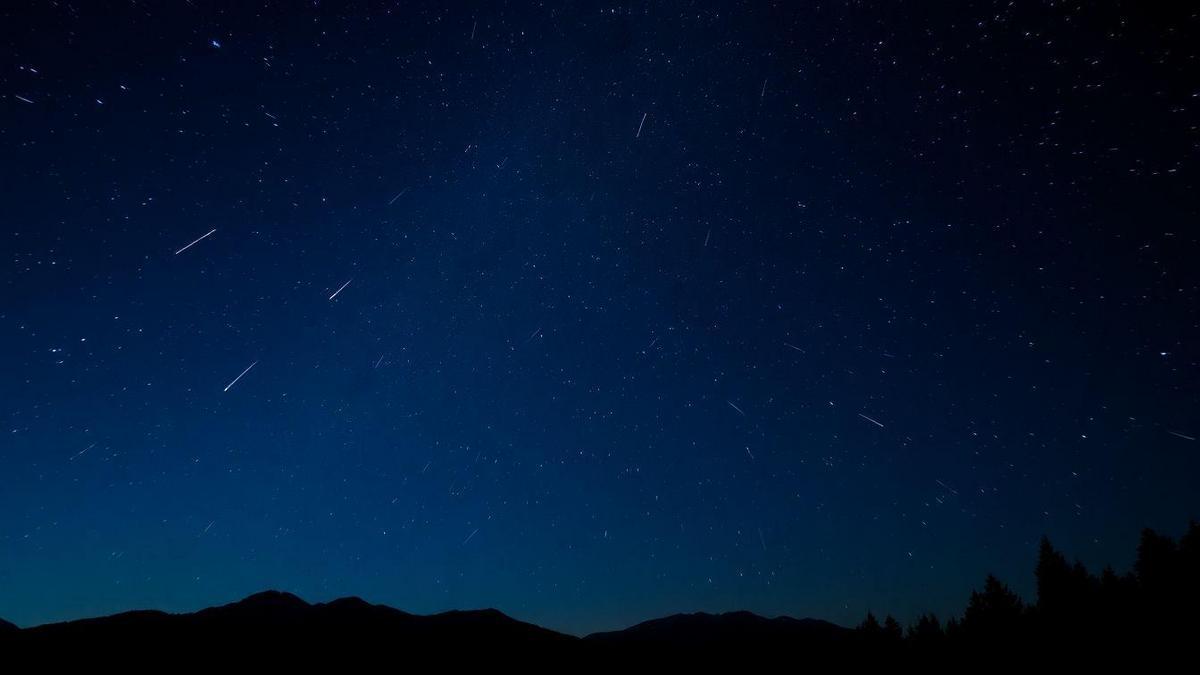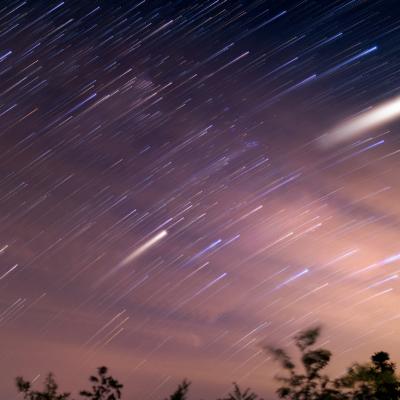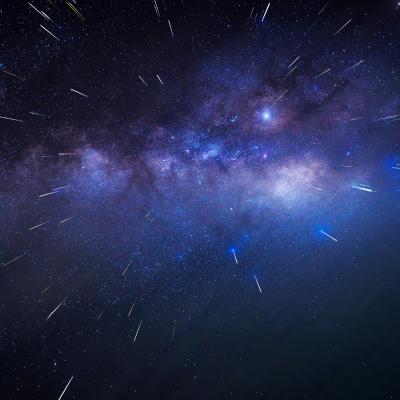Anúncios
Observing meteors and meteor showers is an experience that unites science and natural beauty. These celestial phenomena, in addition to delighting the eyes, spark curiosity about how the universe works. With every luminous streak across the sky, we are reminded of our connection to the cosmos.
Understanding what lies behind these “shooting stars” brings us closer to astronomy and the history of the solar system. From dust particles to trails left by comets, there is much to explore. And the best part: it is possible to enjoy this spectacle with the naked eye, without complex equipment.
Anúncios

What Are Meteors and How Do They Form
Meteors are small fragments of rock or space dust that enter Earth’s atmosphere. When they collide with the air at high speed, they burn up and create a luminous trail. This visible glow is what we call a meteor or shooting star.
These particles may originate from asteroids or comets that have lost parts along their orbits. When these fragments cross Earth’s path, atmospheric entry occurs. The intense friction generates heat and light, resulting in the visible phenomenon.
The size of meteors can vary greatly, from tiny grains to larger rocks. The larger and faster it is, the brighter the meteor will be. In extreme cases, we have what are known as bolides — exceptionally bright meteors.
It is important to note that if a fragment survives the burn and reaches the ground, it is called a meteorite. These objects are rare and valuable for study. Analyzing them can reveal clues about the origin of the solar system.
How Meteor Showers Occur
Meteor showers happen when Earth crosses a trail of debris left by a comet or asteroid. As it enters this band, the fragments enter the atmosphere and become meteors. The result is an increase in the number observed in a short period.
These trails are formed by particles expelled from comets as they approach the Sun. The heat causes ice and rock to break off, creating a cloud of fragments. This cloud remains in space and crosses Earth’s orbit annually.
Each meteor shower is associated with a specific celestial body. For example, the Perseids shower is linked to comet Swift-Tuttle. The annual recurrence of these events makes it possible to predict peak activity dates.
During the peak of a shower, it is possible to observe dozens of meteors per hour. The phenomenon is most visible in dark, cloudless places. That’s why many enthusiasts travel to areas far from cities.
How Do Meteors and Meteor Showers Work?

Meteors and meteor showers are fascinating phenomena that capture the imagination of astronomers and sky enthusiasts around the world. Meteors, often referred to as “shooting stars,” are particles of dust and rock that enter Earth’s atmosphere at high speeds. When these particles, which can range in size from sand grains to larger stones, collide with the atmosphere, they heat up rapidly due to friction, creating a bright trail of light. This phenomenon is what we observe as a meteor. When a meteor is especially bright, it is called a “bolide.”
Meteor showers occur when Earth passes through a trail of debris left by a comet or asteroid. This debris consists of particles that break off the celestial body as it approaches the Sun. When Earth travels through this trail of particles, the rate of visible meteors increases dramatically, resulting in a meteor shower. There are several known meteor showers, each associated with a specific comet or asteroid, and each occurring at predictable times of the year, allowing sky watchers to prepare for these displays.
Advantages of Watching Meteor Showers and Celestial Phenomena
Watching meteor showers and other celestial phenomena offers a range of benefits that go beyond simple aesthetic appreciation. First, these experiences provide a deeper connection with the universe. When people watch a meteor shower, they are reminded of the vastness of the cosmos and the dynamics that govern our solar system. This connection can inspire a sense of humility and wonder at nature and its marvels.
In addition, observing meteor showers can be an educational activity. Many schools and astronomical organizations host observation events during meteor showers, where experts explain what observers are seeing and provide information about the history and science behind these phenomena. This not only increases participants’ knowledge but can also spark interest in astronomy and science in general.
Another advantage of watching meteor showers is the opportunity for social interaction. Many people gather in groups to observe these events, creating a community atmosphere where they can share their experiences and knowledge. This strengthens social bonds and promotes a sense of belonging among astronomy enthusiasts. Moreover, group observation can make the experience more fun and memorable.
Finally, observing meteor showers can be an effective way to escape the daily routine and reconnect with nature. In a world increasingly dominated by technology and urban distractions, spending a night under the stars can be a refreshing experience. The tranquility and beauty of the night sky offer a much-needed break, allowing people to reflect and appreciate the beauty of the world around them.
Tips for Watching Meteor Showers

To have a good experience, choose a location far from city lights. Dark environments, such as fields or remote parks, are ideal. The less light pollution, the more meteors you will be able to see.
Arrive early and allow your eyes to adjust to the darkness. This can take about 20 to 30 minutes. Avoid looking at bright screens during this time to maintain your adaptation.
Check astronomical forecasts to know the best day and time for the shower’s peak. Apps and specialized websites help you plan your observation. This way, your chances of seeing a large number of meteors increase.
Bring items that provide comfort during observation. A reclining chair, blanket, and snacks make the night more pleasant. And don’t forget to wear weather-appropriate clothing, since this activity usually takes place at dawn.
Benefits of Watching Celestial Phenomena
Watching meteors connects people with the vastness of the universe. It’s an opportunity to reflect on our place in the cosmos. The natural beauty of the night sky inspires admiration and respect for science.
This practice can also be educational and spark interest in astronomy. Many schools and observatories host events during meteor showers. This makes learning more accessible and fun.
Moreover, it’s a chance for social interaction in observation groups. Sharing the moment with friends or strangers creates bonds. Conversations under the stars enhance the experience and make it memorable.
Finally, it’s a form of relaxation and escape from a hectic routine. Being in contact with nature and gazing at the sky can relieve stress. It’s a mental break amid the fast pace of daily life.
How to Make the Most of Meteor Showers and the Celestial Show
To make the most of meteor showers and the celestial spectacle, there are a few tips that can help observers have a more rewarding experience. First, it’s important to choose a suitable observation site. A place far from the light pollution of cities, such as parks or rural areas, is ideal for seeing the night sky in its fullness. The darker the environment, the more visible the meteors will be.
Secondly, it’s advisable to check the dates and times of meteor showers. Each shower has a specific peak, and knowing when these peaks occur can increase your chances of seeing meteors. Many astronomy websites and mobile apps offer updated information about meteor showers, including predictions on intensity and visibility.
Another important tip is to allow your eyes time to adjust to the darkness. After arriving at the observation site, it’s advisable to wait about 20 to 30 minutes for your eyes to adapt to the dark. This will allow observers to see more meteors, as their pupils will dilate and adjust to low-light conditions.
Finally, it’s always good to bring a blanket or reclining chair to sit comfortably during observation. The experience will be much more pleasant if observers can relax and look at the sky without worrying about discomfort. Also, bringing snacks and drinks can make the experience even more enjoyable, allowing observers to enjoy a night under the stars in a relaxed way.
Did You Enjoy Learning About Meteor Showers and the Celestial Show of Cosmic Debris?
Meteor showers and related celestial phenomena are an incredible part of our universe and offer a unique experience to those who venture out to watch them. The beauty and grandeur of these events are truly inspiring, and the connection with the cosmos they provide is priceless. If you haven’t yet had the chance to witness a meteor shower, now is the perfect time to prepare and join in on this wonderful experience.
So don’t miss the chance to explore the sky and marvel at the wonders it has to offer. By venturing into meteor shower observation, you’ll not only witness an impressive spectacle but also connect with the history and science that permeate our universe. Get ready for an experience that may change your perspective on the world around you.
Frequently Asked Questions
What are meteor showers?
Meteor showers are when many meteors appear in the sky. They look like shooting stars. This happens when Earth passes through dust left by comets.
When can I see meteor showers?
You can see meteor showers on specific dates throughout the year. Some months are better, like July and August. Keep an eye on the calendar!
Where is the best place to watch meteor showers?
The best place is far from city lights. Choose a dark location like parks or fields. The darker it is, the better the view!
Why are meteor showers important?
These showers show how amazing space is. They remind us that there are things beyond Earth. It’s a celestial show of cosmic debris!
Are meteors dangerous to us?
No, in general, meteors burn up when entering the atmosphere. They break apart before reaching the ground. So relax and enjoy the sky’s beauty!
